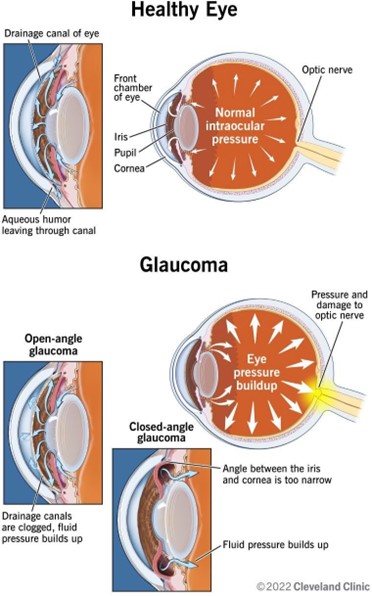The practical nurse (PN) is reviewing a client's recent ophthalmic screening test results. Findings of optic neuropathy, loss of peripheral vision, and increased intraocular pressure are consistent with which medical condition?
Glaucoma.
Macular edema.
Cataract.
Diabetic retinopathy.
The Correct Answer is A
Glaucoma is a group of eye diseases that damage the optic nerve and cause vision loss. It is often associated with increased intraocular pressure, which can compress the nerve fibers and reduce blood flow to the retina. The most common type of glaucoma, open-angle glaucoma, causes gradual loss of peripheral vision.

The other options are not correct because:
A. Macular edema is a condition that causes swelling and fluid accumulation in the macula, the central part of the retina that is responsible for sharp and detailed vision. It can cause blurred or distorted vision, but it does not affect the optic nerve or the peripheral vision.
B. Cataract is a condition that causes clouding of the lens, which is the transparent structure that focuses light onto the retina. It can cause blurred, dim, or yellowed vision, but it does not affect the optic nerve or the intraocular pressure.
C. Diabetic retinopathy is a complication of diabetes that damages the blood vessels in the retina and causes bleeding, leakage, or scarring. It can cause blurred, fluctuating, or darkened vision, but it does not affect the optic nerve or the intraocular pressure.
Nursing Test Bank
Naxlex Comprehensive Predictor Exams
Related Questions
Correct Answer is C
Explanation
The correct answer is Choice C:
Gather the procedure tray and equipment. Choice A rationale:
Placing the client in an orthopneic position (sitting upright and leaning forward) is not necessary for a thoracentesis procedure. The position may be uncomfortable for the client and does not facilitate the procedure.
Choice B rationale:
Keeping the client NPO (nothing by mouth) and encouraging them to void before the procedure is not directly relevant to a thoracentesis. NPO status might be indicated for other procedures requiring anesthesia but not for a bedside thoracentesis.
Choice C rationale:
This is the correct choice. The PN should prepare by gathering the procedure tray and equipment before the healthcare provider arrives to perform the thoracentesis. This ensures that all necessary items are readily available for the procedure.
Choice D rationale:
Cleansing the site and covering it with a sterile towel is a task usually performed by the healthcare provider who will be performing the thoracentesis. The PN's role is to prepare the necessary equipment and assist the provider during the procedure.
Correct Answer is D
Explanation
This comment shows empathy, respect, and support for the client, without being intrusive or judgmental. The PN acknowledges the client's feelings and offers companionship, which can help reduce isolation and loneliness.
The other options are not correct because:
A. This comment may be perceived as coercive or dismissive of the client's feelings, as it tries to persuade the client to do something he does not want to do or enjoy.
B. This comment may be perceived as accusatory or interrogatory, as it questions the client's decision or motive for staying in his room.
C. This comment may be perceived as minimizing or invalidating the client's feelings, as it implies that the client should not be sad or that his family is doing enough for him.
Whether you are a student looking to ace your exams or a practicing nurse seeking to enhance your expertise , our nursing education contents will empower you with the confidence and competence to make a difference in the lives of patients and become a respected leader in the healthcare field.
Visit Naxlex, invest in your future and unlock endless possibilities with our unparalleled nursing education contents today
Report Wrong Answer on the Current Question
Do you disagree with the answer? If yes, what is your expected answer? Explain.
Kindly be descriptive with the issue you are facing.
